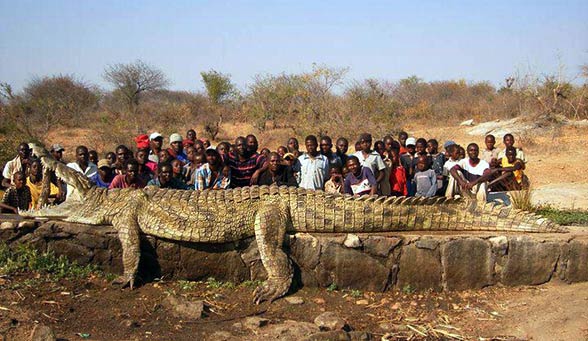
"The Forbidden Pit Monster of Africa"
A tale of giant monsters in a cursed land

Let's take a journey into Africa and explore an early 20th-century tale of forbidden cursed lands and monstrous creatures. Our tale comes from several newspaper articles from the early 1920s when little was known about the Dark Continent. The story, "Mystery of Big Hole" "Pit in Darkest Africa", was reported by a newspaper called the "New Zealand Guardian" in their October 17, 1925, issue.
In this story Mr Frank V. Worthington, Batoka District Commissioner, Secretary for Native Affairs 1904 - 1914, had heard of this mysterious sinkhole lake that was believed to be fed by an underground river system. The sinkhole lake was feared by the local natives who believed it to be cursed by a water-dwelling monster that would eat those who ventured near the shore.
From the article.
"A visit has lately been made to the pit by a friend of Mr. Worthington, who was Native Commissioner there. He found the strange pit, though it was hard to get a native guide to take him there, and peered into the depths in which water from some underground river has risen not to within forty feet of the top."
"Lewanki, the late chief of the Barotse, a very intelligent man, more than once told Mr. Worthington that near marshes about the Forbidden Pit he had seen an animal like a monstrous hippopotamus, but many times larger, which swirled away as he looked but left behind it the traces of its crawling limbs like ruts of wagon wheels."
These reports by Mr. Worthington inspired newspapers with conjecture about relic dinosaurs surviving in unknown regions of the world, something that was in the public's imagination at the time. The tale told by Chief Lewanki, as reported by Mr. Worthington, may have been influenced by novels like "The Lost World" by Sir Arthur Conan Doyle, published in 1912, about an expedition to the Amazon Jungle of South America where prehistoric animals still survived.
However, this story of a swamp monster, as told by the chief, seems unrelated to the monster said to inhabit the forbidden pit. If Chief Lewanki's story is to be believed, then I imagine that the huge hippo-like marsh monster, known to the natives as the Lengolengole, was in the swamps between Lake Chilengwa and Lake Ishiku. However, his kingdom was in western Zambia, with the forbidden pit at the edge of his territory.
Where is this mysterious place in Africa with the forbidden pit?
The country said to have this pit was referred to as North Rhodesia, now present-day Zambia. The tribes there were, the Mashona or Shona of Zimbabwe, Matabele of Rhodesia, and the Ba-Ila, who seemed to live the closest to this pit and its resident monster. It was said that the Ba-Ila had become so frightened by the pit monster that some tribesmen were tied together and thrown into the lake as a sacrifice to the monster that lived there. The Ba-Ila tribe, who feared the forbidden pit, inhabited the upper reaches of the Kafue River in Zambia during the 1920s. The river goes far upstream to the northeast into the Copperbelt Province northwest of Luanshya and Ndola.
The Kafue River is fed by the huge Lukanga Swamp, a primordial area indeed. Also, the upper reaches of the Kafure River is a limestone karst area with numerous caves, underground rivers, and sinkholes. So many sinkholes that to this day they still have problems with them in that area. Lake Kashiba is a giant sinkhole lake with a legend that it is inhabited by a shadow-stealing monster. The lake is situated 80 miles southwest of Ndola town north of Luanshya, known for its numerous sinkhole lakes. The area is surrounded by swamps and is northeast of the giant Lukanga Swamp.
It seems that the forbidden pit could be somewhere between Luanshya and Ndola and the large animal reported by tribal "Chief Lewanki" (actually Lewanikia chief of the Lozi people of western Zambia) was in the marshes near Luanshya. But I dug a little deeper and found the native legends and quotes from the original reports pinpointing the exact location of the forbidden pit.
"The River Snake of the Copperbelt and Shaba Pedicle"

". . . for William Kennelly, a British South Africa Company Collector, encountered notions of a similar creature in May 1900 when he visited Lake Chilengwa, a . . . 'sunken lake' eight miles east of Chiwala's village (modern Ndola). The Africans accompanying him were said to have 'a superstitious horror of the place, and did all they could to dissuade Mr. Kennelly from going down to the water,' some 30 yards below its rim, 'assuring him that there was a large snake there'." (Chesnaye 1901:48).
"Chilengwa . . . is said to be linked by an underground passage to Lake Kashiba, some 80 miles to the southwest (Doke 1975:124-25)."
Lake Kashiba's 'Ichitapa monster'.
"It is said that if a man stands on the rocks by the lake's edge with his shadow falling on the water, the Ichitapa will swim up and swallow the shadow. The man will either become paralyzed or will fall into the lake and drown. If one's shadow is eaten then death is inevitable, say the local tribesmen. (Dobney 1964:25)."
So we now know that the Forbidden Pit monster was said to inhabit a sinkhole called Lake Chilengwa and that lake was believed to be connected to another sinkhole lake called Kashiba 80 miles away. Lake Kashiba was reported to be home to Ichitapa, a water monster that would swallow the shadow of a person on its shores that would paralyze them, causing them to drown, and then be eaten.
Other legends tell of a giant snake monster in the region.
"Nsanguni, on the other hand, was the name given to the fabulous Luanshya River snake which was held responsible for the floodings and deaths during the early development work at Roan Antelope Mine (Doke 1927:324; Spearpoint 1937:3-8)."
The most likely candidate for the giant monster snake is the African rock python, the longest African snake that can reach lengths of 30 ft long. It lives near rivers in the area and is often seen after flooding. It is also suspected as a man-eater in at least one case of a 10-year-old being eaten by one believed to be 20 ft long. Given the forbidden nature of the sinkhole lakes and the rock python's habit of living by the water, it is possible that back in the early 1900s one could have inhabited Lake Kashiba or Lake Chilengwa which grew to an enormous size.
Concerning the story told by Chief Lewanikia about a swamp-dwelling creature many times larger than a hippo, the earliest and most credible story states that he never actually saw the creature, just its tracks and the wake left behind after it submerged. After looking at pictures of hippo trails, his description of the trail is more like that of a large crocodile. The crocodile has a long life span and it never stops growing until it finally dies. Some of the largest crocs ever caught measured over 20 ft and weighed over 3,000 lbs.
Given that some of the chief's reported descriptions claim he saw a large lizard with a tail like an iguana, an extremely old and large crocodile seems a likely explanation. The average size of a common hippo is about 10 feet up to 15 feet long and can weigh as much as 5,000 lbs. An extremely large crocodile would be about twice the size and only 3/5s the weight of a large hippo, but given how Chief Lewanikia never actually saw this "monster" it is understandable how its size could have been exaggerated.

Comment about this article on the
Epress Forum Board
.
|



